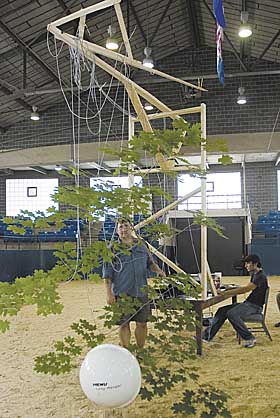  |
| HOME | THIS ISSUE | CALENDAR | GRANTS | BACK ISSUES | < BACK | NEXT > |
Forest scientist branches into high-tech analysis of trees’ motionby Elizabeth Omara-Otunnu - September 7, 2005 |
||||
|
Technology used to create special effects in the Lord of the Rings and Star Wars movies is being applied to the study of trees. Mark Rudnicki, an assistant professor of natural resources management and engineering who specializes in forest science, is using an electromagnetic tracker for his research on the mechanisms by which trees react to wind. In the forest, he says, the way trees sway and collide affects the dynamics of a stand of trees, including the size of each tree’s crown and the competition among individual trees for resources such as space and light. Rudnicki says his experiment is “the first step in a mechanistic understanding the role of branches in how trees resist wind pressure and what it takes to blow over individual specimens and whole forests.” The tracking system includes a sphere that emits an electro-magnetic field. Sensors located within the field report their position and orientation 240 times a second to a unit that transforms the data into a form that can be recorded by a computer. Rudnicki says the sensors measure very precisely how a particular point is moving, recording “six degrees of freedom”: three coordinates to identify position in space, and three – roll, pitch, and yaw – that characterize orientation. The technology is more commonly used to capture human motion, and has been used in sports science – to analyze a golfer’s swing, for example – and the training of athletes, as well as for creating special effects in movies and animation in video games. The first phase of Rudnicki’s project involves measuring the motion of individual branches in response to force applied under experimental conditions. Eight sensors attached to different sections of the branch in a hierarchical pattern record the amount of movement and the time taken for the branch to return to its starting position. Each branch is “loaded” and its movement recorded five times, first with the leaves on, and again after the leaves are stripped, to assess the drag provided by the leaves, which slows the branch’s motion. The second phase, scheduled to begin next year, will measure the movement of trees in the forest. “When we measure trees in situ, most major branches will have a sensor,” Rudnicki says,“so we can see how the whole tree dampens out.” In this year’s experiment, force is applied to the branch near the end that is clamped. In natural conditions, however, the wind generally affects the outer end of branches first. “The end of the branch is where the most force is felt, and the leaves are where the most drag is,” says Rudnicki. During the second phase of the project, he will study whether branches sway in or out of phase with each other. His hypothesis is that branches sway out of phase with each other and that this acts to dissipate wind energies that would otherwise be sent to the trunk base and might cause breakage or uprooting. The data are being analyzed initially using an algorithm known as the Fast Fourier Transform. “Since we are measuring motion in three dimensions, the analysis is complex,” says Rudnicki.
“We are trying to collapse all the dimensions into one, to simplify the data so we can make comparisons between branches and species.” The data show that the amount of force applied affects the range of motion but not its frequency or the rate at which it damps down. “Their sway frequencies are amazingly consistent between loadings,” says Mike Tosca, an undergraduate honors student majoring in math who is one of Rudnicki’s research assistants. Tosca, a senior this fall, will base his honors thesis on the mathematical analysis of the data. The experiment currently involves three species of tree – red oak, sugar maple, and white ash. “Each species seems to have its own patterns of movement,” Rudnicki says. “We think maple has greater lateral movement, for example, while oak, which is heavier, bounces more. “Different species have different wood densities and other wood properties, and the branching patterns and angles are different,” he says. All these affect the type of motion. The presence or absence of leaves also has a tremendous effect on the range of motion, though how this affects the sway frequencies has not yet been analyzed. Rudnicki may add an evergreen species, such as white pine, to the experiment. He suspects that their motion will be more consistent between branches. “Evergreens are less plastic than deciduous trees, and possess a more systematic branching pattern,” he says. Rudnicki says in addition to forest management, his research will have applications forarboriculturists making decisions about pruning and thinning individual trees. With knowledge of how affect individual branches affect overall tree stability, pruning strategies may be developed that reduce the risk of trees being blown down by the wind. The project is funded through McIntire-Stennis funds, federal funding that supports state-designated institutions’ cooperative forestry research programs. Rudnicki, who joined the faculty in 2004, teaches courses on forest ecology and environmental issues. He holds a bachelor’s degree from Colorado State University, a master’s from Michigan Technological University, and a Ph.D. from the University of Alberta. |
| ADVANCE HOME UCONN HOME |

